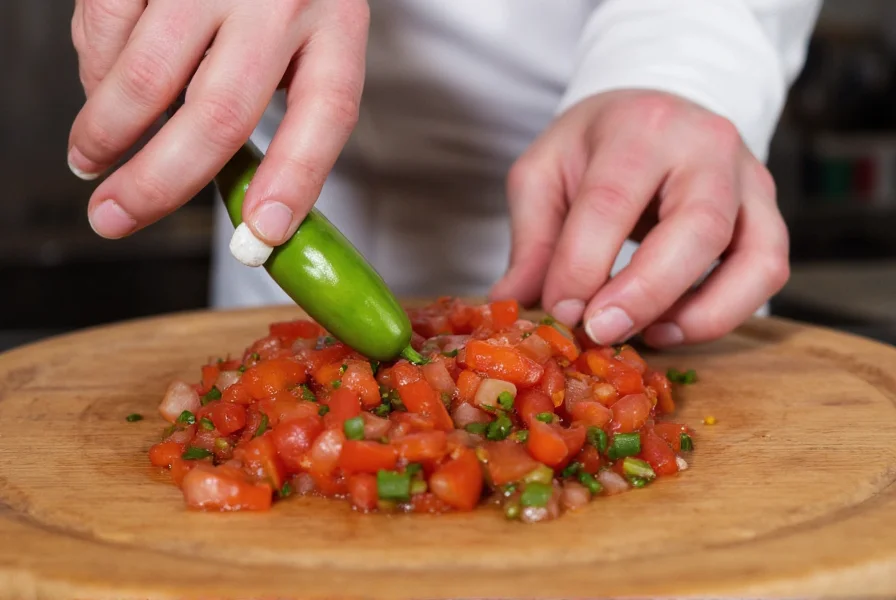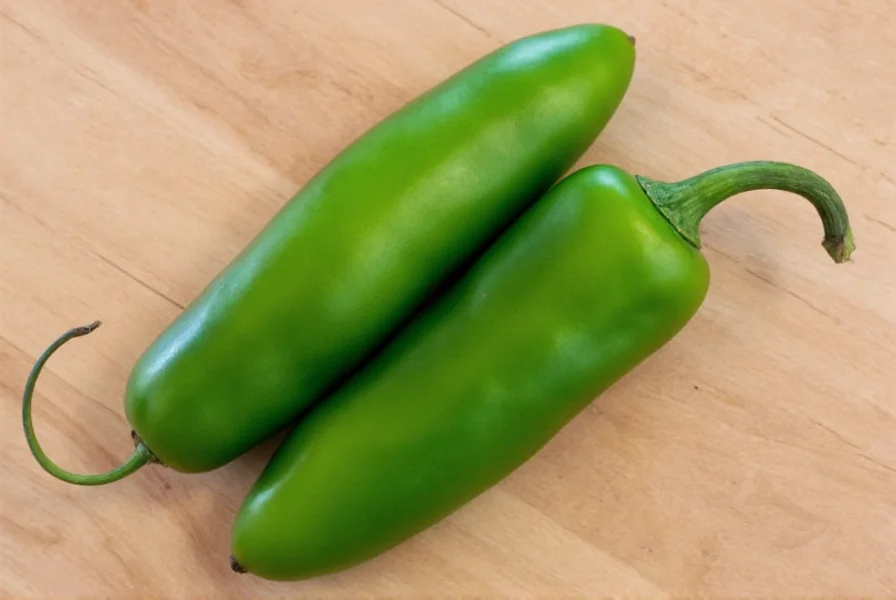When comparing jalapeño vs serrano pepper characteristics, heat level is the most dramatic difference home cooks encounter. This fundamental distinction affects everything from recipe substitution to handling precautions. Let's explore these popular chili peppers in detail to help you make informed culinary decisions.
Heat Comparison: Quantifying the Difference
The Scoville scale provides objective measurement of capsaicin concentration. Understanding these measurements is crucial for jalapeno vs serrano heat comparison in recipe development:
| Pepper Variety | Scoville Heat Units (SHU) | Relative Heat Level | Common Culinary Applications |
|---|---|---|---|
| Jalapeño | 2,500-8,000 | Moderate | Salsas, poppers, pickled peppers, mild hot sauces |
| Serrano | 10,000-23,000 | High | Pico de gallo, hot sauces, ceviche, spicy marinades |
This substantial heat difference explains why many cooks wonder which is hotter jalapeno or serrano when planning recipes. Serranos consistently test hotter across growing conditions, though both peppers' heat can vary based on soil, climate, and maturity. The white pith and seeds contain the highest capsaicin concentration in both varieties, so removing these reduces heat significantly.
Physical Characteristics and Flavor Profiles
Beyond heat, these peppers differ in appearance and taste:
- Size and shape: Jalapeños are larger (2-3.5 inches), thicker-walled, and typically smoother with rounded shoulders. Serranos are smaller (1-2.5 inches), slender, and often have slightly wrinkled skin with tapered ends.
- Color progression: Both start green and mature through red, orange, or yellow hues, but serranos maintain brighter color intensity throughout ripening.
- Flavor notes: Jalapeños offer earthier, somewhat grassy flavor with subtle fruitiness. Serranos provide cleaner, brighter heat with distinct grassy notes and less underlying sweetness.
These jalapeno and serrano flavor differences significantly impact dish profiles. Serranos' thinner walls make them less suitable for stuffing but excellent for raw applications where their vibrant heat shines through. Jalapeños' thicker flesh holds up better to roasting and stuffing, developing sweeter notes when cooked.
Culinary Applications and Substitution Guidance
Understanding proper usage prevents recipe disasters. The serrano pepper substitute for jalapeno question requires careful consideration:
- When to use jalapeños: Ideal for dishes requiring moderate heat with substantial pepper presence - think jalapeño poppers, ranchero sauces, or pickled jalapeños. Their thicker walls provide satisfying texture in cooked applications.
- When to choose serranos: Perfect for salsas, ceviche, and hot sauces where clean, intense heat is desired without overwhelming vegetable bulk. Their brighter flavor complements seafood and fresh preparations.
- Substitution ratio: For equivalent heat, use half a serrano for each jalapeño called for in recipes. Remember that jalapeno serrano substitution ratio varies based on individual pepper heat and recipe context.
Chefs developing authentic Mexican cuisine should note regional preferences: serranos feature prominently in central Mexican cooking (like pico de gallo), while jalapeños dominate in northern preparations. This distinction matters for culinary uses of serrano peppers in traditional recipes.

Growing Characteristics and Selection Tips
Gardeners considering growing jalapeno vs serrano peppers should know:
- Maturity time: Serranos typically mature faster (65-80 days) compared to jalapeños (70-85 days).
- Plant structure: Serrano plants grow more upright with peppers hanging downward; jalapeño plants spread more with upward-facing fruit.
- Yield: Jalapeño plants generally produce higher yields per plant.
- Selection: Choose firm, glossy peppers without wrinkles (except natural serrano texture). Darker green specimens often indicate younger, milder heat.
When harvesting, wear gloves regardless of variety - capsaicin transfers easily to skin and eyes. For optimal storage, keep unwashed peppers in the crisper drawer for 1-2 weeks, or freeze for longer preservation. Roasting either pepper before use develops complex flavors while slightly reducing perceived heat.
Nutritional Comparison
Both peppers offer impressive nutritional benefits with minimal differences:
- Excellent source of vitamins C and A
- Contain capsaicin, which may boost metabolism
- Low calorie (about 4 calories per pepper)
- Provide dietary fiber
- Serranos contain slightly higher capsaicin concentration, potentially offering greater metabolic benefits
The serrano pepper nutrition facts show marginally higher vitamin content due to their thinner walls and higher capsaicin concentration, but both varieties make healthy additions to balanced diets. Capsaicin's anti-inflammatory properties remain consistent across both peppers when consumed in typical culinary amounts.
Practical Cooking Tips
Mastering these peppers requires technique:
- Heat control: Remove all white pith and seeds for milder flavor; include some for moderate heat; use whole for maximum fire.
- Handling safety: Always wear gloves when processing multiple peppers, and avoid touching your face.
- Flavor development: Roasting mellows heat and enhances sweetness in both varieties.
- Raw applications: Serranos excel in fresh salsas where their bright heat shines; jalapeños work better when cooked.
- Preservation: Both freeze well, but jalapeños are superior for pickling due to their thicker walls.
Understanding these nuances transforms your approach to how to use serrano peppers in cooking versus their milder cousin. Professional chefs often combine both peppers in layered-heat recipes - using jalapeños for base flavor and serranos for heat spikes.
Conclusion: Making the Right Choice
The jalapeño vs serrano pepper decision ultimately depends on your desired heat level and flavor profile. For family-friendly dishes or substantial pepper presence, choose jalapeños. When you need clean, intense heat that doesn't overwhelm other ingredients, reach for serranos. Remember that individual pepper heat varies, so always taste a small piece before committing to a recipe. By understanding these differences, you'll create better-balanced dishes that showcase each pepper's unique strengths.
Frequently Asked Questions
Can I substitute serrano peppers for jalapeños in recipes?
Yes, but adjust quantities carefully. Use half a serrano for each jalapeño called for in recipes due to serranos' higher heat level (10,000-23,000 vs 2,500-8,000 Scoville units). For raw applications like salsa, this substitution ratio works well, but for cooked dishes, you may need even less serrano as heat intensifies during cooking.
Which pepper is better for making hot sauce?
Serrano peppers generally create superior hot sauces due to their cleaner heat profile and thinner walls that blend smoothly. Their higher capsaicin content delivers more intense heat per volume, while their grassy flavor complements vinegar-based sauces. For milder sauces with more vegetable character, jalapeños work better, especially when roasted first to develop sweetness.
Why do serrano peppers sometimes taste different from jalapeños beyond just heat?
Beyond heat level, serranos have a brighter, more grassy flavor profile with less underlying sweetness compared to jalapeños' earthier, somewhat fruitier taste. This difference comes from varying concentrations of volatile compounds. Serranos' thinner walls also mean less vegetable matter relative to capsaicin, creating a more direct heat experience without the textural component of jalapeños' thicker flesh.
How can I reduce the heat of either pepper without losing flavor?
To reduce heat while preserving flavor, carefully remove all white pith and seeds (where most capsaicin concentrates), then soak the pepper pieces in milk or a dairy-based solution for 10-15 minutes before use. The casein in dairy binds with capsaicin. Alternatively, roasting either pepper caramelizes natural sugars, creating complex flavors that balance heat perception without removing capsaicin.











 浙公网安备
33010002000092号
浙公网安备
33010002000092号 浙B2-20120091-4
浙B2-20120091-4